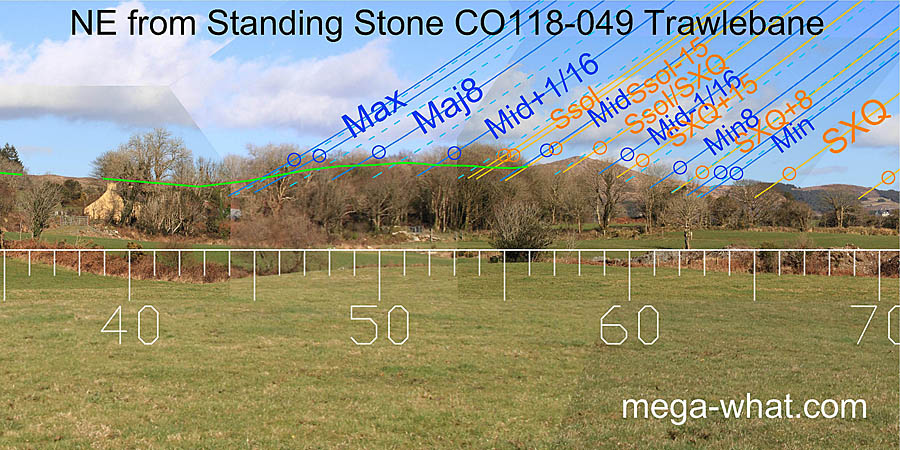 The general direction of South is roughly indicated by the lowest dip but is accurately marked by the last hilltop of a ridge [Pic].
The general direction of South is roughly indicated by the lowest dip but is accurately marked by the last hilltop of a ridge [Pic].
North is on a nearer ridge but obscured [Pic].
Green lines approximate hidden horizon segments.
 The north-east is partly obscured but summer cross-quarters are on a low top,
lunar minor standstillLunistice positions vary cyclically over an 18.6 year period but are fairly static for more than a year at either end of the range
falls in a dip and the cross-quarter / solstice midpoint is on a pointed hilltop.
The north-east is partly obscured but summer cross-quarters are on a low top,
lunar minor standstillLunistice positions vary cyclically over an 18.6 year period but are fairly static for more than a year at either end of the range
falls in a dip and the cross-quarter / solstice midpoint is on a pointed hilltop.
 Eastwards is a local ridge that is somewhat lacking in obviously accurate markers but
a prominent dip is exactly one quarter-month before autumn equinox and winter cross-quarters are at the right hand end of the hilltop.
Eastwards is a local ridge that is somewhat lacking in obviously accurate markers but
a prominent dip is exactly one quarter-month before autumn equinox and winter cross-quarters are at the right hand end of the hilltop.
 To the south-east, winter cross-quarter, winter solstice and lunar major standstillLunistice positions vary cyclically over an 18.6 year period but are fairly static for more than a year at either end of the range
all fall on high points at ridge ends.
To the south-east, winter cross-quarter, winter solstice and lunar major standstillLunistice positions vary cyclically over an 18.6 year period but are fairly static for more than a year at either end of the range
all fall on high points at ridge ends.
 The south-western hill's south top and its northern slope into the notch provides a precise indicator for the days around winter solstice.
The south-western hill's south top and its northern slope into the notch provides a precise indicator for the days around winter solstice.
Tralibane Five Stone Circle, c.170m to the north-east is accurate for the lunar midpoint and the line between the two sites allows for significant measurements.
 The western horizon is fairly useful with the equinox falling on a hilltop.
The western horizon is fairly useful with the equinox falling on a hilltop.
 A very local ridge to the north-west is largely obscured but lunar major standstillLunistice positions vary cyclically over an 18.6 year period but are fairly static for more than a year at either end of the range
would be at or close to the top.
A very local ridge to the north-west is largely obscured but lunar major standstillLunistice positions vary cyclically over an 18.6 year period but are fairly static for more than a year at either end of the range
would be at or close to the top.
- Trawlebane (Tralibane) Five Stone Circle is c.170m north-east (30°)
- Trawlebane (Tralibane) Standing Stone CO118-047 is c.540m south-west (244°)
- Baurgorm (E) Five Stone Circle is c.1.9km south-west (250°)
References
- Archaeological Survey of Ireland, record details. www.archaeology.ie/archaeological-survey-ireland
- POWER, D. et al. 1992 Archaeological Inventory of County Cork, Volume 1: West Cork. Dublin: Stationary Office. p66, no 492.
